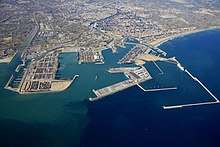Port of Valencia
The Port of Valencia is a seaport located in Valencia, Spain. It is the fifth busiest seaport in Europe. As of 2019, it moves an annual cargo traffic of around 81 million tonnes and 5.4 TEU, ranking first in Spain and second in the Mediterranean basin in container shipping (after the Port of Piraeus),[7] and second in Spain in annual cargo traffic, after the Port of Algeciras.
| Port of Valencia | |
|---|---|
 Harbour | |
| Location | |
| Country | Spain |
| Location | Valencia |
| Coordinates | 39.4457°N 0.3199°W |
| UN/LOCODE | ESVLC[1] |
| Details | |
| Operated by | Port Authority of Valencia |
| Type of harbor | Natural/Artificial |
| Size | 600 ha (6 sq km) |
| Available berths | 40 |
| Wharfs | 72 |
| Employees | 15,000 people[2] |
| General manager | Rafael Aznar Garrigues |
| Statistics | |
| Vessel arrivals | 7,287 (2007)[3] |
| Annual cargo tonnage | 81 million tonnes (2019)[4] |
| Annual container volume | 5.4 million TEU (2019)[5] |
| Passenger traffic | 474,814 passengers (2007) 199,335 passengers (2008)[6] |
| Website www.valenciaport.com | |
The port is also an important employer in the area, with more than 15,000 employees who provide services to more than 7,500 ships every year.
History
The history of the Port of Valencia began in 1483, when King Ferdinand the Catholic granted Antoni Joan the privilege of building a wooden bridge on the beach of the Grao district, called the Pont de Fusta.
From 1483 until the 19th century, various construction projects were built in the port, but because of periodic flooding of the Turia River and the continual movements of sand on the beach the port was not notably successful. However, traffic did increase incrementally over time and the king eventually granted trading privileges with other kingdoms and sovereign states in 1679 and for the Americas in 1791, with Valencia becoming the sixth maritime province in Spain.
Description
The three ports controlled by the Port Authority of Valencia are in Valencia, Sagunto and Gandía. They are located on the shores of the Mediterranean Sea, along an 80 km stretch of Spain’s eastern coastline.
The Port of Valencia is the centre of economic activity in an area of influence encompassing a radius of 350 km, which generates 51 percent of Spain's GDP and includes half the entire working population of the giant country. The port has a quay length of 12 km and a total storage area of 300 acres (1.2 km2).
Satellite ports
Port of Sagunto
This port has an annual traffic capacity of 10% of the entire port – its main cargo is liquefied natural gas; three million tonnes of gas are shipped per year due to the regasification plant located nearby.
Around 70% of the port's current traffic consists of iron and steel products and the rest of fertilizers, construction materials, timber and perishable products.
Statistics

In 2007 the Port of Valencia handled 53,592,859 tonnes of cargo and 3,042,665 TEU making it the second busiest cargo port in Spain and the largest container port in the country.[8]
| Year | 2006 | 2007 |
|---|---|---|
| Fishing* | 254,603 | 339,324 |
| Liquid bulk* | 4,355,965 | 5,543,232 |
| Dry bulk* | 7,148,231 | 7,322,671 |
| Nr of passengers | 345,063 | 474,814 |
| Containers (TEU) | 2,612,049 | 3,042,665 |
| Containers* | 28,157,269 | 32,526,654 |
| Other cargoes* | 7,624,309 | 7,860,978 |
| Vessels (nr) | 7,046 | 7,287 |
| Total*' | 47,540,374 | 53,592,859 |
- * figures in tonnes
See also
- List of ports in Spain
- List of busiest ports in Europe
- List of world's busiest container ports
- Valencia Street Circuit
References
- "UNLOCODE (ES) - SPAIN". service.unece.org. Retrieved 28 April 2020.
- Port of Valencia number of employees Archived 2007-08-04 at the Wayback Machine
- Port of Valencia vessel arrivals Archived 2008-12-01 at the Wayback Machine
- "El puerto de Valencia bate su récord de tráfico y abre una brecha histórica con el de Barcelona". ABC. 12 February 2020.
- Top 50 World Container Ports - World Shipping Council
- "Archived copy". Archived from the original on 2009-09-09. Retrieved 2009-01-01.CS1 maint: archived copy as title (link)
- "El Pireo supera a Valencia como primer puerto del Mediterráneo en contenedores". Expansión. 25 February 2020.
- Annual report Archived 2008-12-01 at the Wayback Machine
- Official figures Archived 2008-12-01 at the Wayback Machine
External links
| Wikimedia Commons has media related to Port of Valencia. |
- Official website (in English and Spanish)